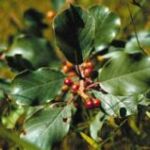| Drug Interactions: |
| Digoxin, Diuretics, Loop Diuretics, Oral Corticosteroids, Thiazide Diuretics |
| Taking buckthorn with these drugs may reduce or prevent drug absorption: |
| All drugs taken orally, (Due to the herb's laxative effect) |
| Taking Buckthorn with these drugs may interfere with the action of the drug: |
| Acebutolol, (Novo-Acebutolol, Sectral) |
Adenosine, (Adenocard, Adenoscan) |
Amiodarine, (Cordarone, Pacerone) |
Bretylium, (Bretylium) |
| Digoxin, (Digitek, Lanoxin) |
Diltiazem, (Cardizem, Tiazac) |
Disopyramide, (Norpace, Rhythmodan) |
Dofetilide, (Tikosyn) |
| Esmolol, (Brevibloc) |
Flecainide, (Tambocor) |
Ibutilide, (Corvert) |
Lidocaine, (Lidoderm, Xylocaine) |
| Mexiletine, (Mexitil, Novo-Mexiletine) |
Moricizine, (Ethmozine) |
Phenytoin, (Dilantin, Phenytek) |
Procainamide, (Procanbid, Pronestyl-SR) |
| Propafenone, (Gen-Propafenone, Rhythmol) |
Propranolol, (Inderal, InnoPran XL) |
Quinidine, (Novo-Quinidin, Quinagulate Dura-Tabs) |
Sotalol, (Betapace, Sorine) |
| Tocainide, (Tonocard) |
Verapamil, (Calan, Isoptin SR) |
| Taking buckthorn with these drugs may increase the risk of hypokalemia (low levels of potassium in the blood): |
| Acetazolamide, (Apo-Acetazolamide, Diamox Sequels) |
Azosemide, (Diat) |
Beclomethasone, (Beconase, Vanceril) |
Betamethasone, (Celestone, Diprolene) |
Budesonide, (Entocort, Rhinocort) |
| Budesonide and Formoterol, (Symbicort) |
Bumetanide, (Bumex, Burinex) |
Chlorothiazide, (Diuril) |
Chlorthalidone, (Apo-Chlorthalidone, Thalitone) |
Cortisone, (Cortone) |
| Deflazacort, (Calcort, Dezacor) |
Dexamethasone, (Decadron, Dexasone) |
Ethacrynic Acid, (Edecrin) |
Etozolin, (Elkapin) |
Flunisolide, (Aerobid, Nasarel) |
| Fluorometholone, (Eflone, Flarex) |
Fluticasone, (Cutivate, Flonase) |
Furosemide, (Apo-Furosemide, Lasix) |
Hydrochlorothiazide, (Apo-Hydro, Microzide) |
Hydrocortisone, (Anusol-HC, Locoid) |
| Hydroflumethiazide, (Diucardin, Saluron) |
Indapamide, (Lozol, Nu-Indapamide) |
Loteprednol, (Alrex, Lotemax) |
Mannitol, (Osmitrol, Resectisol) |
Medrysone, (HMS Liquifilm) |
| Mefruside, (Baycaron)—Used for elevated blood pressure |
Methazolamide, (Apo-Methazolamide, Neptazane) |
Methyclothiazide, (Aquatensen, Enduron) |
Methylprenisolone, (Depo-Medrol, Medrol) |
Metolazone, (Mykrox, Zaroxolyn) |
| Olmesartan and Hydrochlorothiazide, (Benicar HCT) |
Polythiazide, (Renese) |
Prednisolone, (Inflamase Forte, Pred Forte) |
Prednisone, (Apo-Prednisone, Deltasone) |
Rimexolone, (Vexol) |
| Torsemide, (Demadex) |
Triamcinolone, (Aristocort, Trinasal) |
Trichlormethiazide, (Metatensen, Naqua) |
Urea, (Amino-Cerv, UltraMide) |
Xipamide, (Diurexan, Lumitens) |
| Taking buckthorn with these drugs may interfere with the actions of the herb: |
| Aluminum Hydroxide, (AlternaGel, AluCap) |
Aluminum Hydroxide and Magnesium Carbonate, (Gaviscon Extra Strength, Gaviscon Liquid) |
Aluminum Hydroxide and Magnesium Hydroxide, (Maalox, Rulox) |
Aluminum Hydroxide and Magnesium Trisilicate, (Gaviscon Tablet) |
| Aluminum Hydroxide, Magnesium Hydroxide, and Simethicone, (Maalox, Mylanta Liquid) |
Calcium Carbonate, (Rolaids Extra Strength, Tums) |
Calcium Carbonate and Magnesium Hydroxide, (Mylanta Gelcaps, Rolaids Extra Strength) |
Famotidine, Calcium Carbonate, and Magnesium Hydroxide, (Pepsid Complete) |
| Magaldrate and Simethicone, (Riopan Plus, Riopan Plus Double Strength) |
Magnesium Hydroxide, (Dulcolax Milk of Magnesia, Phillips' Milk of Magnesia) |
Magnesium Oxide, (Mag-Ox 400, Uro-Mag) |
Magnesium Sulfate, (Epsom Salts) |
| Sodium Bicarbonate, (Brioschi, Neut) |
|

